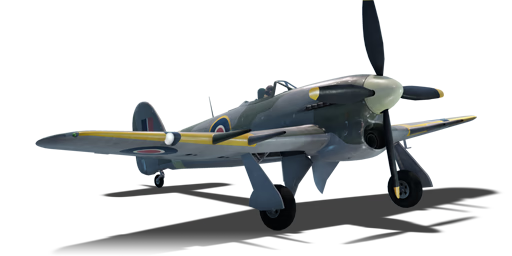



The Typhoon Mk Ib/L is a British fighter. It has been in the game since the start of the Open Beta Test prior to Update 1.27.
The Typhoon is a heavily armed, fast fighter bomber which excels in Boom and Zoom tactics. It is armed with four deadly Hispano cannons, which can obliterate enemy fighters with the air targets belt. With all modules purchased, the Typhoon is one of the fastest planes in its tier, reaching speeds of almost 700 km/h in level flight. You also have an excellent climb rate and great manoeuvrability, enabling you to dogfight quite effectively against some targets.
You also get some decent payload options. A choice of 2 x 250, 500 or 1,000 lb bombs or 8 x RP-3 rockets allow you to hit enemy ground targets hard and fast. Just beware that carrying such payloads will adversely affect your flight characteristics. In realistic battles ground forces, it is best to assess the situation on the battlefield. If the enemy team is ground forces heavy, you can choose to thin them out with bombs or rockets. You can even use your cannons to good effect on light targets like the Wirbelwind and PT-76. If the enemy team has a high volume of aircraft in the air, leave the payload and just focus on taking them out.
flaps
flaps
flaps
brake
| Belt | Belt filling | Armor penetration (mm) at a distance: | |||||
|---|---|---|---|---|---|---|---|
| 10 m | 100 m | 500 m | 1000 m | 1500 m | 2000 m | ||
| HEI/SAP-I/T | 22 | 20 | 14 | 9 | 6 | 4 | |
| AP-T/HEI/SAP-I | 37 | 35 | 25 | 16 | 10 | 7 | |
| T/HEI/SAP-I/HEI/SAP-I | 22 | 20 | 14 | 9 | 6 | 4 | |
| AP-T/T/HEI | 37 | 35 | 25 | 16 | 10 | 7 | |
| AP-T/SAP-I/HEI/AP-T | 37 | 35 | 25 | 16 | 10 | 7 | |
| HEI/HEI/SAP-I | 22 | 20 | 14 | 9 | 6 | 4 | |












Flight performance | |
|---|---|
Survivability |
|---|
Weaponry | |
|---|---|